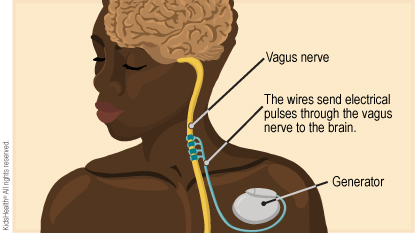Vagus Nerve Stimulator Therapy for Epilepsy
What Is Vagus Nerve Stimulator Therapy?
Vagus nerve stimulator (VNS) therapy is a treatment for epilepsy. The vagus (VAY-gus) nerve runs up the sides of the neck and into the brain. The VNS sends electrical pulses to the nerve, which carries the pulses to the brain. This helps prevent or shorten the length of seizures.
What Are the Benefits of VNS Therapy?
When used along with medicine, VNS therapy can:
- help kids have fewer seizures
- make seizures that do happen less severe
- stop a seizure that has started
Managing seizures gives a child a better sense of control over their condition. Many parents report that their child is happier, less anxious, more alert, and feels better overall with VNS therapy.
Children are also less likely to need to go to the hospital for their seizures and may be able to take fewer medicines.
Who Can Get VNS Therapy?
Vagus nerve stimulator therapy works best in children who are at least 4 years old, and:
- have partial (focal) seizures
- take medicines for epilepsy, but haven’t had an improvement
- are not good candidates for epilepsy surgery

How Is the Device Placed?
The vagus nerve stimulator is placed during a brief surgical procedure:
- The child gets medicine to make them sleepy and comfortable.
- The doctor makes a small incision (cut) in the skin of the chest.
- The doctor places a small device called a generator in the chest.
- The doctor threads wires from the generator up to the left vagus nerve and wraps them around it.
- The doctor closes the incision with a few stiches and puts a bandage over it.
The wires from the generator send electrical pulses to the vagus nerve, which then carries them to the brain. The wires do not enter the brain.
After the procedure, it is normal for a child to feel a little sore. In the hospital, the care team will make sure they feel comfortable. Most children feel better and go home the same day.
Are There Risks to VNS Therapy?
VNS therapy is very safe and most people do not have any problems. When the pulses happen, some kids might cough, have a hoarse voice, or have a funny feeling in their throat. These often get better with time. The health care provider will go over all risks before your child has the procedure.
How Does the Device Work?
The generator gives out small electrical pulses regularly throughout the day. This helps prevent seizures. Also, if a seizure is about to happen, the generator will sense this based on your child’s change in heart rate. Then, it will send out extra pulses to prevent the seizure or make it less severe. This is called “autostimulation” mode.
Your care team will program the device and teach you how to use and care for it.
What Happens if My Child Has a Seizure?
Sometimes, even if the generator is working well, seizures still happen. If your child is having a seizure, you may be able to stop it or lessen its effect by using a VNS handheld magnet. You’ll swipe the magnet across the skin over where the generator is placed. It triggers the generator to send a strong signal to the brain to stop the seizure.
Your care team will teach you when and how to use the VNS magnet.
What Else Should I Know?
It might take some time before kids who get a VNS device start having fewer seizures. Most families see improvement after a few months to a year or two.
Tell all health care providers that your child has a VNS device. The device needs special care to protect it during routine tests or procedures, such as a magnetic resonance imaging (MRI) scan.
If you have questions or concerns, talk to your child’s doctor. You also can find more information online at:
